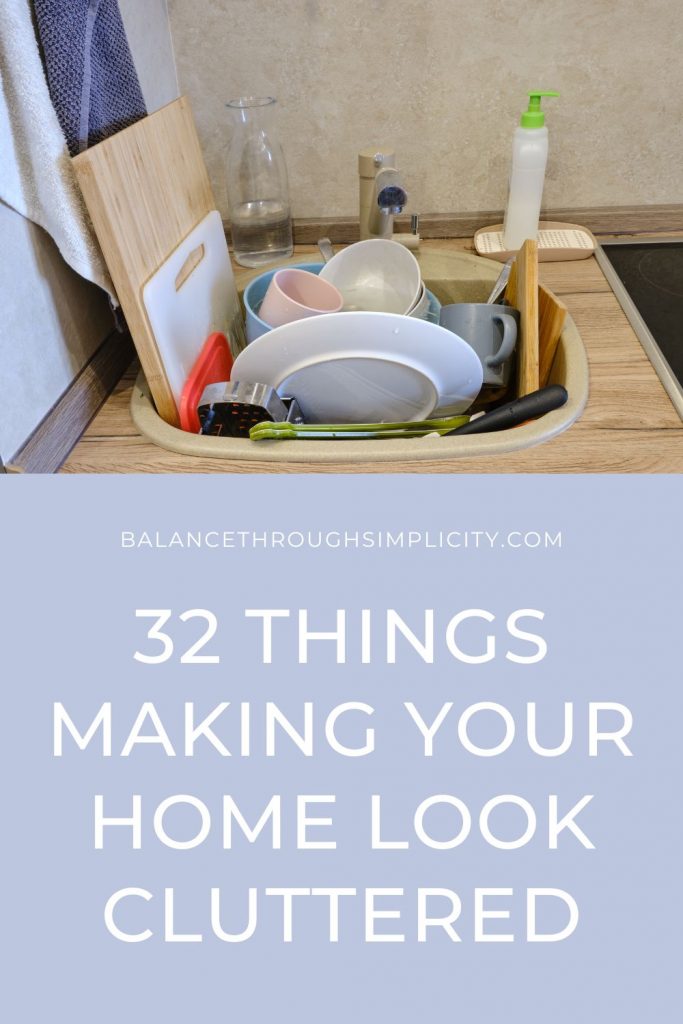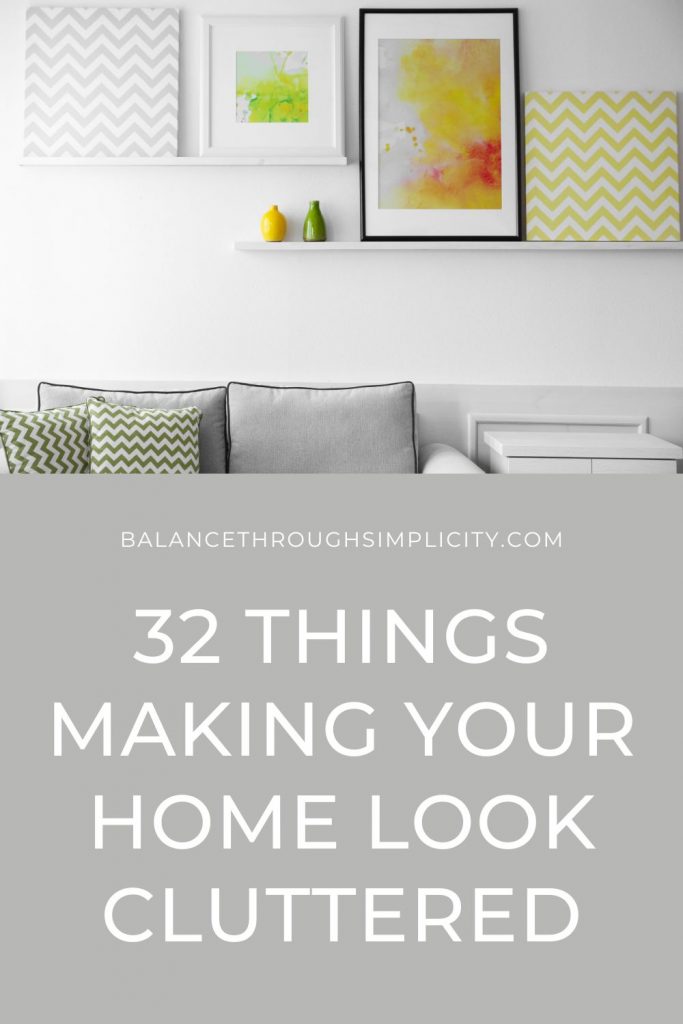THINGS THAT MAKE YOUR HOME LOOK CLUTTERED
Does your home look cluttered? In this article I’m sharing some things that make your home look cluttered and what to do about it.
DECLUTTERING YOUR HOME
Decluttering can be difficult enough. Sometimes we don’t have time to declutter, we feel overwhelmed at how to declutter our entire home, or we have so much stuff and not enough energy or motivation to declutter or we get stuck in a decluttering rut and can’t find a way out. Yet, how amazing it feels when you do begin to clear your stuff and create space, time and freedom for enjoying your home and life instead of just managing it!
This sounds wonderful but when you take a look around your home what do you see? You might have decluttered and put in place some regular decluttering habits to stay clutter-free but then, why does your home sometimes STILL feel busy and cluttered? It’s so frustrating!
In this article I’m sharing some tips and things that make your home look cluttered, and what to do about it.
THINGS THAT MAKE YOUR HOME LOOK CLUTTERED
Depending on your personal taste and the decor and style you like to have around your home, here’s a list of things that can make your home look cluttered and busy. I’ve suggested some ideas on how to overcome them to simplify your home and space. Everybody’s home looks different so this isn’t a list of things you should do or not do, but hopefully some tips if you’re still frustrated by clutter!
1. Wires and cables that are untidy or trailing
Tuck them behind furniture, tie them neatly and safely and check out the internet and Pinterest for useful storage and organisation solutions for wires and cables.
2. Too many pictures on the wall
Too much on the walls can be visually distracting, especially if they’re of different shapes, sizes, colours, mismatched frames and not in straight rows or lines. Choose your favourite artwork and photos and let them stand out by having plenty of blank space in between.
3. Mismatched home décor
If you have a vast array of décor items with different colours, styles, shapes, patterns and designs they don’t come together in a cohesive aesthetic. Decorating and accessorising your home is a great way to bring individuality and expression but if it’s mismatched and not thought out, it can just feel eclectic and cluttered.
4. Conflicting patterns
Patterns can be a useful design tool to bring colour and contrast but too many different patterns in a small space can feel busy and cluttered.
5. Spreading items out
If you cluster décor items together, usually in groups of odd numbers, 3 or 5 for example, it feels and looks more intentional instead of dotting single items on a shelf or on a wall.
6. Mismatched storage containers
It’s great to shop your home and use what you have already but storage containers of different sizes, shapes, materials and colours can make a room look less than organised. See what a difference it makes to what you’re storing and how it looks when you try using a range of co-ordinating containers.
7. Cluttered flat surfaces
Flat surfaces are notorious clutter hotspots but have you noticed how clearing them can instantly make a room feel clutter-free? Put in place some clutter-free habits to keep those tabletops and counters free of clutter.
8. Too much furniture
Look around your room and think about how you use the room. Only put in the room the furniture that you’ll need to fulfil its purpose. Having too much furniture, especially furniture that is too big for the room, will make that space feel overcrowded and cluttered.
9. Don’t be afraid of blank space
Just because you have empty space on a wall, a shelf or in the corner of your room, don’t feel you have to use and fill it. Blank space is a useful design tool in giving the mind and eye space and it allows what you do have to stand out amongst the rest.
10. Stuff that doesn’t have a home
If you don’t give everything a home or storage space to live when it’s not being used, it’s likely you’ll find it dumped on a countertop or corner of the floor. Create a home for everything and return items to that home when they’re not in use. If you can’t find a home for it, do you really need it?
11. Floor clutter
Just like clear counters, a clear floor gives the illusion of a clutter-free home. It allows for more continuity and flow from room to room as well as more space to walk and move around.
12. Conflicting colours
Too many different colours might be your design preference but, if colour’s not used right, it can also create busyness and distraction. If you want colour in your home, consider using variations of one colour or just small accents and pops of colour instead of on big walls or surfaces. Here are some tips on minimalism for people who love colour instead of bare white walls!
13. Fridge and freezer doors
Photos, notes, kids’ artwork. They all find a way to be stuck on our fridge or freezer door. Remove them all and see what a difference it makes! Can you find a way to keep them anywhere else, even if it’s scanned digitally into your photos?
14. Noticeboards
I try to use digital planners or a single notebook wherever possible but if you find a noticeboard the best way to keep you organised and efficient then go for it. But, try to keep it updated, remove old and obsolete paperwork. Arrange everything neatly and tidily and use matching pins or clips to hold everything in place.
15. Paper clutter
Paperwork gets everywhere. It could be letters in the post, junk mail, newspapers and magazines, packaging, letters from school. Set up a system for actioning, filing, saving and shredding paperwork and keep to it every week. Here are some tips on how to declutter paperwork and be less overwhelmed by paper clutter.

16. Open shelving
Wherever possible try to keep things behind closed doors. This way, if your shelves aren’t neat and tidy, at least you won’t be able to see what’s inside!
17. Untidy shelves
My daughter is a great one for organising her books in rainbow order. I have to admit it makes her shelves look so tidy, even if the books are different sizes! Now we organise all the books and our clothes in rainbow order too.
18. Too much stuff
If you have too much stuff, your home is going to look cluttered, no matter how tidy and organised you are. If you want to be clutter-free, declutter first then organise!
19. Collections of things
If you collect things, keep them all in one place, grouped together if possible. Having them spread out around a room can make your home look cluttered.
20. Blankets, cushions and throws
I love to snuggle up under a blanket when I’m reading but I have a basket next to my sofa where I keep the blankets when they’re not in use. Too many accessories like these can clutter up a space, particularly a small space. Choose your favourite, create a place to store them and don’t buy anything new unless you love it more than what you have already and you know where you’re going to keep it after you’ve purchased it!
21. Piles of laundry
Put a load of laundry on as often as your household requires it and make a pact with yourself to not go to bed until that laundry is clean, dry, folded and put away. Read more simple household routines to manage your home easily.
22. Lighting
When you think about how you use a room and the furniture in it, also take a moment to consider the lighting. You need lighting that suits how you’re going to use that room. Maybe this means different layers of lighting such as a ceiling light for the main light source and a table or desk lamp for focused work. If you have random, extra lights consider how and when you use them.
23. Shoes
I have a busy family and each one of us have several pairs of shoes and boots. It’s so easy for our entrance way, storage cupboard and closets to get filled up with footwear and this can easily make your home look cluttered. Research different shoe storage options and choose one that will fit in a strategic place that you can all get into the habit of using. Even a big box where shoes can be thrown into is better than shoes just thrown all over the floor! The trick to staying organised is that it needs to be as easy to stay organised as it is to just dump your stuff. When things are too complicated we don’t use or do them! Big bins, baskets and storage containers for shoes are easy for kids and adults alike to put them in.
24. Too much décor
I love making my home look and feel inviting and cosy but I’m also aware that too much décor and accessories can make my home just look cluttered. Limit your décor, choose your favourites, switch them out with the changing seasons but don’t go overboard with the number or variety!
25. Dishes in the sink
Get into the habit of washing up straight after you’ve used a plate, mug, glass etc. Wash and rinse by hand or put it in the dishwasher to run and finish before you go to bed at night. Dry things and put them away rather than leaving them to airdry on the counter or draining board. Read more about how to keep kitchen counters clutter-free.
26. An untidy entrance way
What do you see when you first walk in through your front door? For many of us it’s the stuff that’s in our entrance way. Make a good first impression on yourself and any guests by keeping your entrance way neat, tidy and clutter-free. Invest in storage solutions and encourage your family to get into the habit of using it!
27. Toy clutter
If you have kids then you’ll be familiar with the clutter caused by too many toys invading every space in your home. Declutter the toys, set up a storage system for the ones you’re keeping and see how your home and your kids benefit from fewer toys.
28. Your nightstand
This isn’t a place for clutter to live. Just like the rest of your bedroom, it should be clear, calm, restful and set up for a great night’s sleep. Here are some tips on how to declutter your bedroom and why it matters.
29. Random remote controls
Decide which remote control are functioning and actually in use. Get rid of the old and obsolete ones. Find a place for the controls to live that looks neat and tidy instead of them just being left in the place where they were set down. Maybe a drawer, on a little tray or in a pretty basket. This keeps them together and might help you find them easier too!
30. Unwanted stuff you’ve decluttered
Here are some tips on what to do with unwanted stuff you’ve decluttered. Don’t leave it lying around the home in boxes or bin bags waiting to be taken to the donation or recycling centre. Do it now whilst you think about it and as part of the decluttering process. You haven’t decluttered properly until it’s left your home (or your car!).
31. Unmade beds
A made bed instantly makes your bedroom look neat and tidy. Making your bed is also a great daily habit to signal your body and brain to start the day. Get your kids to make their beds too as part of their chores!
32. Cleaning supplies left out
Talking of chores, cleaning supplies and equipment left out can make your home look cluttered and aren’t exactly pretty to look at. Store them out of sight when not in use. Here are some tips on how to spend less time cleaning!

WHAT CLUTTERS YOUR HOME?
I’d love to know what clutters your home? What do you do to keep your home looking clutter-free and tidy? Leave a comment below!
HELPFUL RESOURCES TO DECLUTTER YOUR HOME
Here are some resources and articles to stop making your home look cluttered:
- 20 ways to declutter your home
- Decluttering in midlife
- Decluttering mistakes and how to overcome them
- Clutter blindness – what it is and how to overcome it
- Simplify Your Home – a complete guide and handy checklists to help you declutter your home and keep that clutter away

